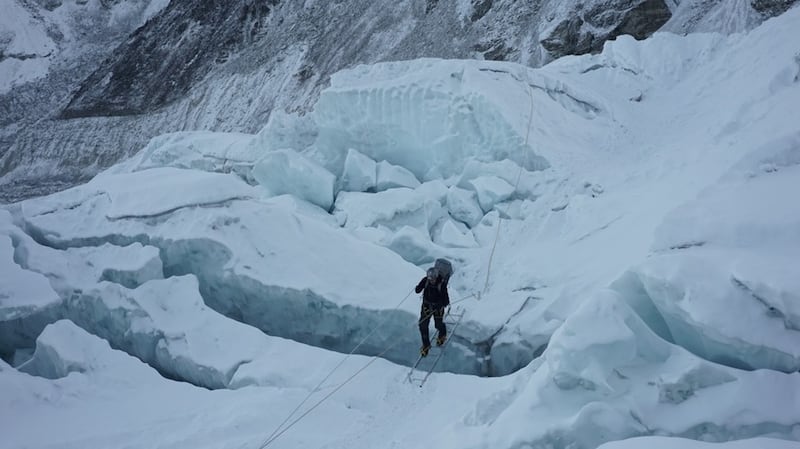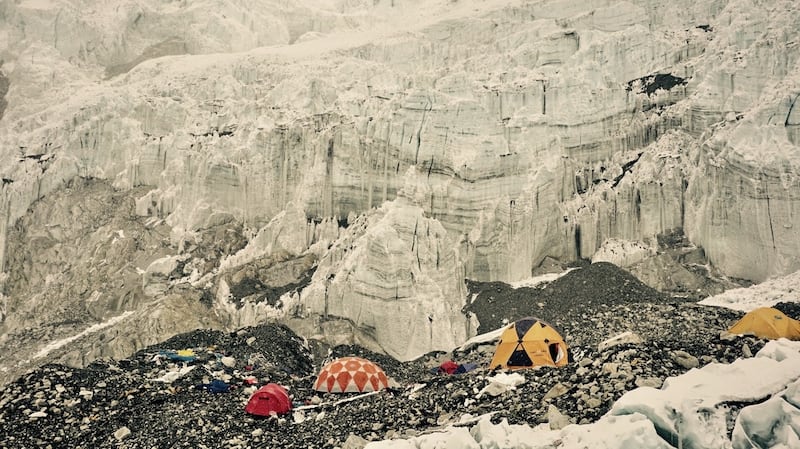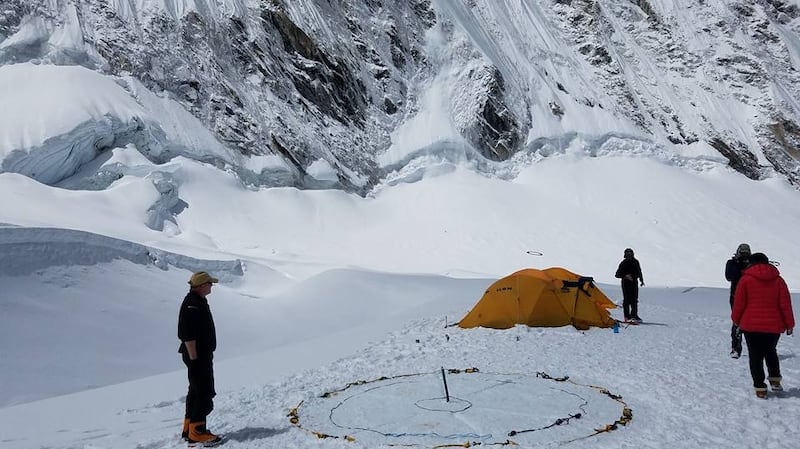I woke shortly after 2am last Saturday morning. Our plan was to meet for breakfast at 3am, leave Everest Base Camp (EBC) around 3.30am and head straight through the Khumbu Icefall for Camp I. Although we are an expedition team, we weren’t expecting to travel together, with climbers going at their own pace.
This is for two reasons: firstly, if a fast climber needs to wait for a slower climber, they’ll get cold. If a slow climber feels under pressure to go fast, they will get sweaty and out-of-breath, potentially bringing on exhaustion, AMS (acute mountain sickness) and frostbite. Secondly, a team trying to move together through the icefall will be slow and expose themselves to dangers from the environment. Climbers want to spend as little time under teetering seracs as possible.
I felt like I crossed the icefall entirely on my own, apart from occasionally passing a group of climbers on my way up: Koreans, Americans, Sherpa, and Japanese. I made good time but took extra care clipping into the ropes, using the jumar up the steeper passages and ladder sections, and using the figure-8 for the odd abseil.

Billy had been having some difficulties with his breathing which meant he would be going slower and he was to leave EBC earlier, around 3am, accompanied by a Sherpa. Ronny decided to leave with Billy to give himself more time.
We all set out looking to journey through as much of the icefall as possible before the heat of the sun turned it into a furnace. Nevertheless, there would still be a wide variation in journey times between members of the expedition group.
The icefall is like nothing I’ve been through before. It’s a sumptuously sculpted obstacle course of crevasses, icewalls, and seracs. As the darkness began to lift, the majesty of the towering ice structures revealed itself.
Soon enough, we met our first ladders, three roped together on a vertical ice cliff. I rehearsed my now familiar routine: unclip the jumar from the harness, attach it to the cow tails using the locking carabiners, making sure the shorter cow’s tail is the main attachment to the jumar, then locking it off. I would then place my huge cramponed 8,000m mountain boots on the ladder’s first rung (I have size 46 boots even though I wear size 43/44 runners – and for boots of this size my crampons require special extender bars) and start clambering up, using the jumar for support.
Next came the horizontal ladders. I had seen the photos of such ladders and was excited – and a little apprehensive – to have to negotiate this unusual obstacle which would confront us time and again crossing crevasses in the icefall and up the Western Cwm. We had completed a short training session the previous week with a single ladder, which had instilled confidence. But now, faced with a deep crevasse and more than one ladder roped together, the excitement grew.
In general, the favoured technique is to plant the middle of the boot onto each rung and to move steadily. Some climbers make their way by planting toe and ankle on successive rungs. We had been warned that some crampons can become stuck in the rungs using that technique. Unfortunately, getting stuck in the rungs was Billy’s fate on one of the longer ladders. Fortunately for him, a Sherpa travelling in the opposite direction was able to crawl out onto the ladder and release his jammed crampon.
Old enemy
All the while, our old enemy, altitude, had us out of breath after almost every obstacle on the route. The adrenaline also kicked in. This would be awesome, uncomplicated fun in a controlled environment closer to sea level. But up here, on a constantly moving glacier, anything can happen: seracs can unexpectedly come tumbling down; crevasses can open up or widen and the ladders that we are crossing might sway from side to side or back and forth, barely able to cover the gap.
I had the impression that once we had reached 5,900m we’d be through the icefall and that all that remained would be a nice stroll up to Camp I. On reflection, I have no idea where I got that information. The mind plays tricks. I had been going over four hours by this stage and the sun had risen.
I was wearing way too many clothes and was able to partially vent using a variety of zips on softshell pants and tops, but I didn’t want to stop as the terrain had not evened out. Eventually I saw the first set of tents for Camp I and took a turn from the main path to get there. Only when I reached these tents did I discover that I had arrived at an IMG camp (international mountain guides). Recognising that I had made a wrong turn, I had to retrace my steps and then go through a series of dips, each around 50 to 100 feet with sharp drops and inclines, which required ropes to pull oneself up or ease oneself down.
Finally, just under six hours after leaving, I threw off the backpack and crawled into the tent, as much to get out of the now blazing sun as to recover. As drilled, I put the stove straight on and started melting snow for rehydration – I had only one litre with me for the journey.
The fastest contingent in our group broke five hours. The slowest clocked in at around nine hours. We met one person who took 12 hours and heard of another who took 14.
There is still time for the body to acclimatise, but as we complete the second rotations there will be cut-off times to continue to the summit push. We all expect to be faster on the next rotation as our bodies are increasingly acclimatised and we are better accustomed to the terrain.
Constant fight
Tent life at altitude is a constant fight to regulate temperature. With the sun beating down, the temperature can easily reach 30-40C during the day, so we do what we can to vent and get down to bottom layers. No sooner than this is done than clouds close in, or the wind picks up, or it starts to snow and the temperature comes crashing down to zero. This can happen in the space of a few minutes before it goes back to being sunny again just as quickly.
The next day we hiked up to Camp II through the Western Cwm, a valley which stretches from the top of the Khumbu Icefall to the bottom of the Lhotse face. It feels like we are walking through history. Cwm is the Welsh word for a bowl-shaped valley and the Western Cwm was named by George Mallory during the British reconnaissance expedition in 1921.
This is dangerous, heavily crevassed terrain. The small crevasses we can step over, the larger ones have ladders in place. Even more dangerous are the unseen crevasses that lurk beneath and for these we are almost always attached to a rope. As we move into May, more crevasses will open and existing ones will widen and narrow. This is a moving glacier.
It took a little over two hours for me to reach Camp II. It is our secondary staging post after EBC and we have a mess tent complete with a gas heater and full-time cooking staff. On the next rotation we’ll come straight to Camp II on the first day, bypassing Camp I and we’ll stay three or four nights. We chilled in the mess tent for a couple of hours and then made the hour-long return down to Camp I.

The plan for the next day had been for us to hike up to Camp II again and to stay there. We were to be up and ready to leave by 7.30am, but as we gathered we could hear Tim talking to our EBC manager Kami on the radio. There had been an accident in the icefall. Some ice had come loose and landed on the route. A Sherpa had been injured and had to be airlifted to Kathmandu for treatment. Our Sherpa team had immediately returned to EBC rather than wait in the icefall for the route to be fixed.
With our Sherpa team no longer making their way up, we’d be low on supplies and wouldn’t be able to establish ourselves at Camp II. We weighed up options, which included going down, but we ultimately decided to wait another day at Camp I, continue to acclimatise, and hopefully continue our schedule with just a day’s delay.
Frisbee golf
With a day at Camp I ahead on limited supplies, we focused on entertainment first. We had a frisbee with us, but the terrain was far too dangerous for frisbee golf. We therefore focused on creating a large dart board using crampons, ice axe, tent cord, and a couple of climbing slings. A hugely successful ‘doubles’ game ensued with my partner Jonathan repeatedly hitting the double outs for us to win against Billy and Rocket Ronny.

The following day we returned up the Western Cwm to Camp II, clocking in just over 1:45, and spent the day hydrating, playing Monopoly deal and joking around. Despite the extra night at Camp I and this being our second trip to Camp II, that was the worst night of the trip for me thus far. I must have woken up a thousand times. I filled a full two-litre pee bottle. I was cold. I was uncomfortable, sleeping on a thermarest that kept moving. I had a throbbing headache which eventually succumbed to some paracetamol around midnight.
Coming down the Cwm and the icefall was a lot of fun, if you like abseiling and jumping about. The key is still to go slow and ensure you are always clipped into the ropes on the exposed and consequential terrain. Descending over a 1,000m in altitude always feels great as well.
Time for a shower, clean clothes, and a good meal. I’ll sleep like a baby for the next few nights. Being at 5,300m feels like sea level when you return from one of these rotations higher up.
This morning at 3am, we’ll be heading back up through the Khumbu Icefall, up the Western Cwm, and this time up the Lhotse face to Camp III at 7,200m. This will be our second and final rotation to prepare for a summit push in May.
Rory McHugh is climbing Everest in aid of Rory’s Nepal School Project with Child Rescue Nepal, to build schools in off-the-beaten track villages that have yet to recover from the 2015 earthquake. He would greatly appreciate your support on virginmoneygiving.com/letsbuildschools on rorymchugh.com and @realrorymchugh
You can also follow his daily progress all the way to the summit through the Garmin mapping site: share.garmin.com/roryeverest




















